What Are Sliding Tandems on a Trailer? A CDL A Driver’s Guide to Safe, Legal Weight Distribution

For any CDL A driver at Barr‑Nunn Transportation, understanding sliding tandems on a trailer is essential. This often-overlooked skill can mean the difference between hitting the road legally or facing hefty fines and delays at the scale. In this guide, we’ll break down:
- What sliding tandems are and how they work
- Why they matter for safety, compliance, and efficiency
- Step-by-step instructions tailored for truckers
- How much weight moves per hole, and how to calculate adjustments
- Best practices to stay legal and protect your CSA record
What Exactly Are “Sliding Tandems”?
Sliding tandems refer to the movable rear axle group (usually tandem axles) on a semi-trailer that you can shift forward or backward along slider rails. These rails, mounted under the trailer frame, allow you to adjust weight distribution between your tractor’s drive axles and the trailer axles. A locking pin mechanism keeps the axle group securely in place once positioned.
Why Sliding Tandems Is a Critical Trucking Skill
Legal Compliance
Overweight axle groups can trigger citations, out‑of‑service orders, and expensive penalties. Moving tandems lets drivers shift weight to stay within limits; for example, the 34,000‑lb max for tandem axles and 80,000‑lb gross vehicle weight.
Balanced Handling & Safety
Properly distributed weight improves steering, braking, and reduces the risk of rollovers—especially during lane changes or in bad weather.
Fuel Efficiency & Equipment Longevity
Balanced loads reduce wear on suspension, tires, and drivetrain, plus optimize fuel economy.
How Much Weight Is Shifted Per Hole?
Typically, the slider rail holes are spaced to shift about 250 lbs per hole (common in standard trailers), though some systems use 400 lbs per hole, depending on spacing.
Example:
If your drive axles are overloaded by 800 lbs and your trailer uses 400‑lb hole spacing, you’d need to slide forward 2 holes to shift 800 lbs onto the trailer.
Step‑by‑Step Guide: How to Slide Tandems Safely
Here’s a step‑by‑step process adapted for Barr‑Nunn drivers based on industry best practices:
- Park on a level, solid surface. Avoid gravel or ice.
- Straighten your rig. Tractor and trailer must be aligned.
- Set the parking brakes on both units.
- Maximize air pressure.
- Lock the power divider (if equipped). Enhances traction.
- Activate Trailer Hold / Spring Brake Override (or use trailer brake valve).
- Release the slider handle. Pull or lift the mechanism to disengage locking pins, then secure the handle in the retainer.
- Mark your target hole so you know where you’re headed.
- Move the rig slowly:
- Reverse to slide tandems forward (this shifts weight to the trailer axles).
- Drive forward to slide tandems backward (shifts weight to drive axles).
- Re‑engage locking handle when near the target hole, then rock in Drive/Reverse to ensure pins seat correctly.
- Visually confirm the pins are fully seated and the handle is locked.
- Disengage Trailer Hold & unlock power divider.
- Re‑check brakes and alignment.
- Re‑weigh if possible to confirm compliance.
- Document tandem position and any weight adjustments. This helps track patterns and avoid recurring issues.
Calculating How Far to Slide: A Quick Formula
- Weigh your axles (drive vs. tandem).
- Identify the over‑axle (where the excess weight lies).
- Slide toward the problem axle:
- If drive axles are overweight, slide tandems forward.
- If trailer axles are overweight, slide tandems backward.
- Compute required holes:
Overweight lbs ÷ lbs per hole ≈ # holes to move
Sample: If your trailer axles are overweight by 1,050 lbs and per-hole shift is 250 lbs, you’ll need to slide 4.2, rounded to 4 or 5 holes backward.
Best Practices for Barr‑Nunn Drivers
- Know the rules state by state. Some states have tighter front‑kingpin to tandem limits (Bridge Formula). Use the strictest rule on your route.
- Use onboard air‑suspension pressure gauges to estimate axle loads when CAT scales aren’t nearby.
- Slide tandems on a level, clean surface. It’s safer and easier.
- Lubricate rails and keep mechanisms clean—rust or grit can jam the system.
- Train regularly, especially refreshers on older trailers or unfamiliar setups.
- Document each tandem adjustment and outcome—helps in audit or CSA score reviews.
Why This Matters to You
- Helps avoid fines and scale delays—fewer roadblocks, more on‑time moves.
- Preserves CSA safety score—key for continued access to high‑value freight lanes.
- Improves fuel economy and reduces equipment wear—direct benefits to driver earnings and maintenance budgets.
- Promotes safe handling—especially during heavy hauls, tight maneuvers, or bad weather.
Closing Thoughts
Sliding tandems is more than just a mechanical trick; it’s critical to staying safe, legal, and efficient on the road. For CDL A drivers at Barr‑Nunn, this know‑how ensures smoother runs, less scale downtime, and healthier CSA scores. Keep your gear well‑maintained, your processes sharp, and your documentation clean, and you’ll keep rolling miles ahead of the pack.
Final Tips for Sliding Tandems
- Sliding adjusts the weight balance on tractor vs. trailer.
- Shift toward the axle that’s overloaded.
- Typical shift ≈ 250 lbs per hole (some at 400 lbs).
- Always work on a solid, level surface with brakes locked.
- Finish by rocking the rig, securing pins, and verifying visually.
- Know Bridge Formula limits and chart them route‑wise.
- Clean, lubricate, train—repeat.
- Stay sharp, stay safe, and keep those tandems legal out there.